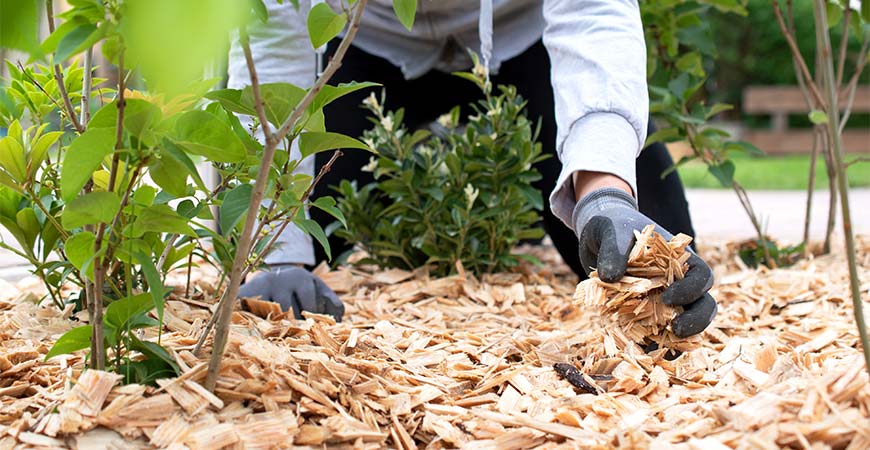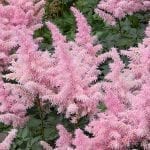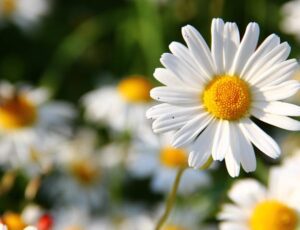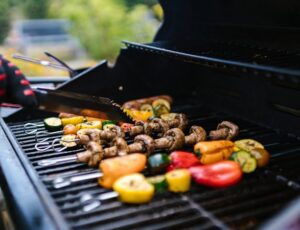
The Benefits of Mulching in the Fall
The time between summer and the holidays is an ideal time to mulch your garden. Mulch adds a protective layer for plants and adds beauty to your garden.
Here we’ll cover fall mulching tips and the benefits of laying down mulch in autumn.
Why should I mulch in autumn?
Mulching in fall adds an extra layer of warmth and protection, shielding your garden and landscape plantings from cold winter temperatures. You can add mulch in fall the same way you do in spring.
Mulch helps retain soil moisture, suppresses weed growth, and prevents soil erosion. Mulching on the soil around your plants refreshes the existing mulch that has partially decomposed over the summer.
Mulching when the temperature is cool insulates the soil. This prolongs a warm soil environment, which benefits plants, earthworms, and essential microbes.
The warm soil allows them to stay active longer and to overwinter in the ground. Mulch improves the soil and moderates the effect of temperature swings.
Mulching in fall insulates the roots of garden and landscape plantings. In cold, northern regions, the soil may freeze solid for some time, but in most areas, the soil routinely freezes and thaws.
This freeze-thaw cycle can stress plant roots and any foliage that grows in the top few inches of soil.
In addition, applying mulch in the fall will free up precious gardening time next spring. Plus, there will be no emerging bulbs or plants to maneuver around.
When should I mulch?
Apply mulch just after the first hard freeze. This is also an excellent time to trim back perennial plants. If you live in a region that experiences early snow, apply mulch just before the first snow forecast.
Note: When mulching, ensure you don’t apply too thick of a layer as this can cause a powdery white mold.
What types of mulch are available for sale?

A wide range of mulch materials are available from garden retailers, or you can make your own from natural materials found in your yard. A pine straw mulch is ideal for acid-loving shrubs such as rhododendron, holly, or azalea.
Shredded bark mulch looks attractive next to a walkway or in a front flowerbed. Piles of shredded leaves raked from the yard make good mulch for a vegetable garden. Natural mulches add beneficial organic matter to the soil. The leaves are also a free natural mulch, so there is no extra cost!
Here’s an overview of the various types of mulch available at garden retailers and home centers–
Wood chips and shredded bark mulch
is a popular choice. It’s inexpensive, lightweight, and adds a pleasing, natural look to your landscape.
Wood mulch will gradually decompose, so you must add a new layer every two to three years. Wood chips are not recommended for flower or vegetable beds because they decompose slowly and can be in the way while digging.
Pine straw mulch
comes from pine trees. It cools and acidifies the soil, which makes it an ideal choice for acid-loving plants such as azaleas and rhododendrons.
Cocoa hull mulch is a by-product of the cocoa industry. Cocoa hull mulch is rich chocolate brown, good for the soil, and smells like chocolate.
This exotic mulch makes an attractive garden addition to enhance plants and shrubs near entrances and doorways.

Straw mulch is a top choice for a vegetable garden. It’s lightweight, clean, and easily decomposes. In the fall, home repair expert Danny Lipford recommends applying a deep layer of straw mulch to your root vegetable garden DannyDanny Lipford recommends applying a deep layer of straw mulch to your root vegetable garden in the fall.
That way, if you’re in a warmer climate, you can keep the ground from freezing so that you can harvest veggies all winter long. Choosing the correct type of straw mulch is important as some may contain hay.
Straw mulch that is part hay will cause weeds to sprout in your garden. Look for weed-free straw mulch. Wheat straw is commonly used, but rice straw is available as well.
Compost is an excellent soil amendment and beneficial garden mulch. Its dark, rich color looks attractive in the landscape.
Shovel compost in a thick layer around vegetable plants and on bare spots. Earthworms will go to work to mix the compost layer with the underlying soil.
Cedar and Cypress Mulch
A chip or bark mulch from cedar or cypress wood repels insects, including termites, carpet beetles, roaches, and ants. The wood contains natural oils, including the chemical thujone, which repels bugs.
Cedar and cypress wood mulch lasts longer than most others as it decomposes slowly. Shovel cedar or cypress mulch around your landscape plants and in beds adjacent to your home to keep insects away.
When choosing mulch, keep in mind that cedar mulch will quickly fade from a reddish-tan hue to light gray – something to keep in mind.
Grass clippings are a natural by-product of mowing the lawn, free and readily available. Rake up grass clippings after you mow to use as mulch. The green clippings contain plenty of nitrogen and make an excellent choice for mulching a veggie garden. Use your clippings instead of letting them go to waste.
Shredded leaf mulch is a free and easily obtained fall mulch. If you have abundant trees on your property, you’re sure to have plenty of fallen leaves to create a nutrient-rich mulch for your flowerbed, pathway, or shrub border.
Shred the leaves by raking them into loose piles and running a lawnmower with a bag attachment over them. You’ll have free mulch from leaves in one afternoon!
You can also have your kids offer to rake your neighbors’ lawn for leaves.
Mulches to Avoid
Manufacturers have come up with clever ways to take recyclable material and turn it into mulch, but some types of mulch aren’t necessarily good for your garden.
Red-dyed mulch is often made of shredded ‘junk’ wood, including old pallets. There’s no guarantee that the wood in red-dyed mulch is chemical-free. The red dye and possible contaminants (such as copper, arsenic, and more) can leach into the soil, harming or killing insects and earthworms.
The artificial reddish color doesn’t blend well with most home gardens or landscape areas.
Rubber mulch is made of recycled and shredded rubber tires. Rubber mulch does not decompose and may contain chemicals that are a part of the tire manufacturing process.
Note: When using bark or hardwood mulch, apply a new layer of mulch each year. Shotgun mold (artillery fungus) is more likely to occur in areas that are not mulched yearly. The spores from this mold can cause spotting on nearby siding and is incredibly difficult to remove.
Did you know?
A mulch layer around the trunk of young trees works as a barrier to keep mower blades and weeds away. Place the mulch a few inches away from the base of the tree.
Piling mulch too high or against the trunk can smother roots and cause moisture buildup, making the tree susceptible to disease.











